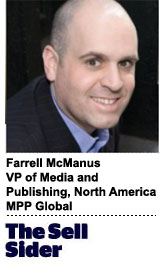 “The Sell Sider” is a column written by the sell side of the digital media community.
“The Sell Sider” is a column written by the sell side of the digital media community.
Today’s column is written by Farrell McManus, vice president of media and publishing, North America, at MPP Global.
We know that Facebook is one of the biggest sources of traffic to other sites, so even a slight algorithm change can dramatically alter a publisher’s destiny.
Last week, it announced plans to help publishers drive subscriptions as part of a new “Journalist Project.” The service promises new storytelling formats, business models, hackathons and even journalism training. The project kicks off this month in a collaboration with German news organization Bild, which will offer free trials to readers right from Instant Articles.
That’s exciting news, but it does beg the question: To what degree is the destiny of your publication dependent on Facebook?
For too long now, publishers have been focused on the race for clicks – an immediate return that doesn’t necessarily guarantee long-term loyalty. That same pressure for clicks has driven the unwitting straight into the arms of Facebook, where they’ve become dependent on the social network’s ability to pass traffic over by the truckload.
But this race for clicks is neither good for the reader nor for the publication. What’s a good publisher to do – simply charge more for ad space and consequently get priced out of the market?
Digital publishers were born into this quandary. The majority were conceived with the notion that advertising was the sole revenue opportunity, whereas traditional publishers knew that a model that relies exclusively on advertising is a poor long-term plan. The fact that digital publishers are beginning to explore multiple revenue streams is proof of this wisdom.
Here’s the hard truth: Diversified revenue models, including getting readers to pay for content that deserves to be paid for, is the way forward. There has never, and will never, be a way around it – if you want to get great journalists paid at the end of the day.
The New York Times is one of the best examples of a healthy revenue mix: a paid content model and a flexible advertising model, mixed with monetization from native advertising and marketing services. The plus of distributing risk this way means it isn’t reliant on sheer traffic volume to sustain ad rates, which will continue to drop, resulting in more click-bait content and frustrated customers.
The New York Times’ recurring, sustainable revenue stream enables a more creative and vibrant organization, one that can experiment with new ad units and placements. Publishers that rely solely on advertising can’t take those kinds of risks.
Multiple revenue streams are the best defense against an overreliance on third-party sites like Facebook, which may yield excellent returns in the short term, but cultivate a dangerous dependence on their models.
It also makes it possible for the Times to deviate from standard IAB ad size units: It can assert it’s putting subscribers first and looking to enhance the reading experience for them.
This translates to higher revenue from existing subscribers: By leveraging technology with intelligence and greater decision capability, the publication can track over time what content each subscriber is most interested in and serve more relevant adverts, resulting in higher engagement.
It is important for all publishers to develop a sustainable business model that works for them. This means striking a healthy balance between advertising revenue and subscription revenue, ensuring they do not rely on a sole revenue stream. The New York Times is doing this to great effect.
We’ll see more publishers pursue a diversified revenue model in the year to come and I’m convinced they’ll enjoy equally great results. Weaning oneself from a cash cow like Facebook may be painful, but it’s also critical to ensuring one’s own survival; no site should be too reliant on likes, after all.
Follow MPP Global (@mppglobal) and AdExchanger (@adexchanger) on Twitter.
This post was syndicated from Ad Exchanger.

More Stories
The One Show AI judge Sherina Florence releases hip-hop album for deadline push
Week of Feb. 17 Cable News Ratings: Fox News and CNN Make Primetime Gains
AppLovin is Officially the New Target of Short Sellers